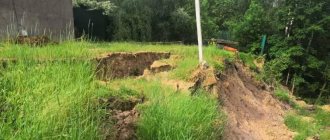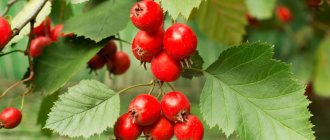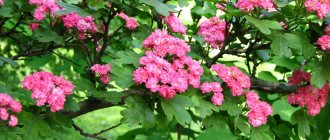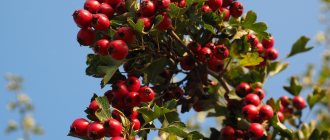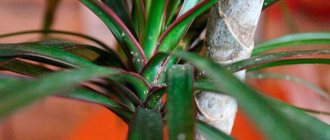In mid-summer, hawthorn ripens in vegetable gardens and garden plots - a beautiful shrub covered with blood-red, orange berries.
Many people want to grow it at home, but do not know how to propagate hawthorn and think that they need to buy expensive seedlings. But you can grow a shrub yourself, without special knowledge and experience. Hawthorn is a spreading, small-fruited, medium-sized shrub from the Rosaceae family. The berries have healing properties; ancient Greek healers used them to treat heart diseases. In addition, bushes are grown as hedges or as decoration for local areas and garden plots.
How to choose cuttings correctly?
The most important thing is to choose the right shoot from which cuttings will be taken in the future. Most beginning gardeners make the big mistake of choosing shoots that grow upward but make poor cuttings. They simply will not be able to form a root system. In order to propagate hawthorn using the cutting method, you need to collect shoots from side branches that do not grow very actively. Also, when cutting cuttings, you need to take into account one feature: if you take one long shoot and cut it into several parts, then the cuttings that were closest to part of the base will take root. In order for the selected shoots to become good cuttings, there are a number of rules. You need to choose shoots:
- Not frozen.
- Which do not have any damage to the cortex.
- Shoots that have matured, that is, annual shoots. It is not advisable, but you can take two-year courses.
- Shoots for cuttings should be taken from the middle tier of the hawthorn. It is advisable to take those that grow from the southern part of the tree’s crown.
- When cutting cuttings, it is necessary to take into account the fact that the length of each should be from 10 to 15 centimeters, and the thickness from 7 to 8 millimeters.
What is hawthorn, its beneficial qualities, features and characteristics
In nature, hawthorn has many species, but only 50 varieties are cultivated in gardens and orchards, which can be propagated without much difficulty using cuttings, seeds obtained from the fruit of the plant.
Since ancient times, this plant has been used by people as an ornamental plant, decorating the landscapes of parks, gardens and local areas. Hawthorn during flowering is a particularly beautiful sight, its appearance is impeccable. The bush is completely covered with white or pinkish inflorescences; against the background of bright green or burgundy foliage they look irresistible, and when the plant is covered with red berries, it becomes simply fabulous.
Traditional medicine has also long ago adopted the healing properties of the plant and uses it for various types of ailments. The fruit contains a large number of microelements, such as potassium, calcium, zinc, iron, copper and others. And vitamins are represented by the following groups: A, E, K, B, C. Tinctures, decoctions and teas based on hawthorn help with the following ailments: diseases of the cardiovascular system, pathologies of the digestive tract, diseases of the nervous system and blood vessels.
Flowers and fruits of the plant are used to prepare medicinal potions, but you should be aware of contraindications and precautions for these medications. The use of these folk remedies is strictly prohibited for certain groups of people, these include children under 12 years of age, pregnant women and nursing mothers. Abuse of such a strong remedy as hawthorn tincture can lead to dizziness and hallucinations.
The usual method of cutting hawthorn
The propagation process is recommended to be carried out in early spring, before the sap process, or in the fall after the leaves fall. After the shoots are selected, cuttings need to be cut from them. It is desirable that the shoots are young. After cutting the cuttings, they must be kept for an hour in a root-forming solution, and then planted in a mixture of peat and sand in a 1:1 ratio. After planting the cuttings in the soil above, you need to moisten them with the root-forming solution in which they were previously located. After planting, the cuttings need to create greenhouse conditions for further rooting; for this, they can be covered with a glass jar on top. During the process of evaporation of moisture from the soil, the same environment will be created inside the jar as in greenhouse conditions.
A bright accent for the garden at any time of the year
If you live in a private house or often visit your summer cottage throughout the year, then hawthorn is exactly the plant that will decorate your garden for all 12 months. In spring, it refreshes the garden with its carved, dark green leaves and lush clouds of inflorescences. In the summer, the hawthorn begins to bear berries, which are decorative at any time of the year, but they look most advantageous in late autumn or winter, when the trees and shrubs have already shed their foliage.
By the way, the foliage of some varieties of this plant stands out not only for its unusual shape, but also for the color it acquires in the fall. Variegated orange-purple leaves add a splash of color to a sad fall landscape.
- 17 spectacular shrubs that will decorate the garden in autumn
A selection of ornamental plants that are attractive both in summer and autumn.
Reproduction by layering
To obtain hawthorn seedlings using layering, shoots from 1 to 2 years old are selected. They must be placed in a pre-dug groove in the ground. The shoot is placed in the groove so that the top of the plant remains on the surface. The laid shoot is secured in the ground with a staple and lightly sprinkled with light, nutritious soil. It is also necessary to tighten the base of the layering with wire. I recommend that gardeners do this method of propagation in the spring, or at least in early summer, this gives the opportunity to get a ready-made seedling in the fall.
During the process of propagation by layering, the plant at the digging site must not only be watered, but also fertilized. Ammonium nitrate solution is very suitable for fertilizer. The plant needs to be fertilized once a month. Also, as young shoots sprout, you need to gradually add soil to strengthen the root system of young plants. The best option would be to mulch them with straw, hay or peat. By autumn, the shoots and hawthorn will take good roots. After this, they must be carefully cut off from the cuttings and replanted as an independent plant.
Hedge
stonemuseum.org
A hawthorn hedge is not only an interesting decorative solution, but also reliable protection against uninvited guests. This is where the thorns, which many species of this shrub have in their arsenal, will serve well. The only drawback of using hawthorn for a dense hedge is that the bushes, “ennobled” by frequent pruning, hardly bloom or bear fruit.
There are a great many varieties of hawthorn, so the choice of plant for growing a hedge depends on each specific purpose. We will describe only some of the species that are suitable for growing hedges.
Arnold's hawthorn does not like full shade, but is drought tolerant, and in summer its white or white-pink flowers turn into reddish or orange sweet berries. Its spines are small (up to 1 cm) and it grows quickly.
Soft hawthorn is distinguished by larger, ovoid leaves and long (up to 9 cm) spines.
Siberian hawthorn (blood red) is a relatively low (up to 4 m) tree with bright red berries. However, it grows slowly, and therefore begins to bear fruit in the 10-15th year of life.
Common hawthorn is a tall (3-8 m) and very hardy tree that can grow in almost any conditions.
The cultivated hawthorn has practically no thorns, but in the literature, in addition to the generally accepted name, you can also find a synonymous one - “prickly hawthorn”.
Fan-shaped hawthorn can “boast” of special endurance and abundant fruiting even in regions with extremely cold climates.
The hawthorn bushes, trimmed in the shape of a parallelepiped, begin to become “bare” over time due to lack of sunlight. Therefore, the best shape for hawthorn growing in a hedge is a trapezoid tapering upward.
- Planting and forming hedges
Everything about hedges - photos, what is best to make from, how to cut and care for them.
Method of cuttings “constriction”
With this method, an already well-formed shoot that has matured is selected. The 3 lower leaves and just below the buds are removed from it, and the shoot is tied well with soft wire.
Then you need to take some moss and rinse it well with boiling water. Then add a little garden soil and a couple of drops of a root stimulant - this could be heteroauxin. The entire mixture is slightly moistened with water from a spray bottle. Then you need to take a cellophane tape measuring 10 by 20 centimeters, put moss and peat mixture on it and bandage the shoot in the place of constriction with cellophane. It should look like you are putting a cast on your arm. The result should be that a cocoon of peat mixture will appear on the shoot in the area of the constriction. In the place where the constriction was made, the process of disrupting the movement of juice that passes from the leaves to the roots will occur. The plant, in turn, will begin to struggle with the constriction, as a result of which a small influx of tissue will form in this place. As a result, after 2 months, roots will form in the place where the constriction will be, and after 4 months the entire cocoon of cellophane tape will be pierced with roots. As soon as this happens, you can carefully cut the shoot from the trunk, just below the constriction site, remove the cellophane and move the cutting with roots for growing.
An unusual method of cuttings
Currently, some gardeners have begun the practice of plant propagation using an unusual but very effective method. This method makes it possible to root even those cuttings that are difficult to graft, for this:
- Hawthorn cuttings are pre-cut.
- Then a potato is taken, from which all the eyes are removed so that the potatoes do not grow.
- After this, a hawthorn stalk is inserted into the potatoes.
- Next, the potato tuber and cuttings are placed in the soil and dug in.
- The top of the cutting is covered with a glass jar.
This method is very effective; with this germination, the seedlings are supplied with a large amount of nutrients that they receive from the potato tuber.
As a result of this propagation method, cuttings actively produce roots. The resulting seedlings subsequently germinate and develop very well.
Cloning
Hawthorn cloning is a relatively new method of propagation that allows you to obtain a huge number of seedlings in a short time (up to several thousand in six months). The essence of the method is that a plant bud, previously washed with a disinfectant, is placed in a nutrient medium.
After growing on a nutrient medium, the plants are transferred to a greenhouse or greenhouse. Next, planting and caring for hawthorn seedlings occurs as for plants obtained by cuttings.
Disadvantage of the method: it requires special laboratory conditions (sterility, nutrient medium, growing room).
How are cuttings grown?
After the cuttings have taken root, most gardeners, before planting the plant in a permanent place, grow the cuttings. To do this, fertile soil is selected, to which up to 200 grams of deficient soil and about 50 grams of chalk are added per 1 square meter. Sprouted cuttings are planted at a distance of 20 centimeters from each other. The distance between rows should be at least 40 centimeters. Growing occurs over a period of 4 years, during which it is necessary to take care of them, water them, remove weeds and loosen the soil. In the second year of growth, plants need nitrogen fertilizers and good watering. Watering must be done abundantly, but rarely. In the future, young plants are formed depending on their further purpose. For hedges, they undergo periodic top pruning to retard upward growth. For group or single plantings, only the side shoots are pruned so that the plant grows upward faster.
Disease Prevention
Common diseases of hawthorn are rust, hole spot and powdery mildew. In case of disease, treat with fungicides. For planting, choose well-ventilated areas and follow the care technology. It is not recommended to place coniferous trees nearby, which are carriers of rust.
As a preventive measure, plants are sprayed with one percent colloidal sulfur, which improves the appearance and increases the immunity of young shoots. Hawthorn propagation is difficult but interesting work. With a serious and thoughtful approach to the process, you can get wonderful young plants that will delight you with their aesthetic appearance and healthy fruits.
